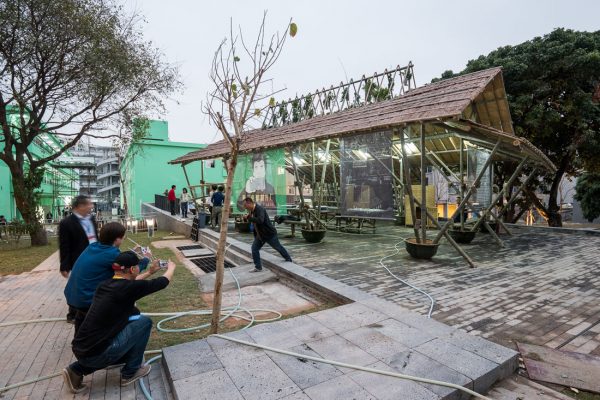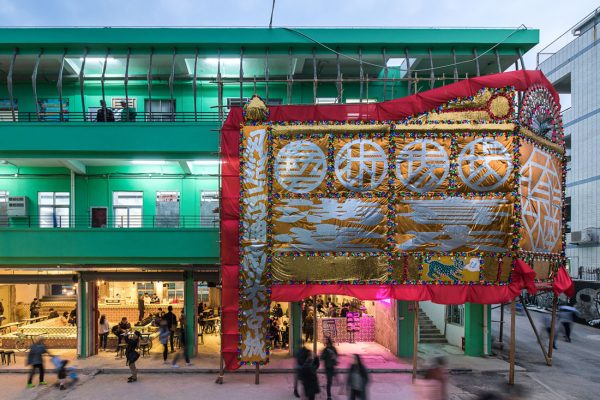MVRDV, Atelier Bow Wow and URBANUS head to Hong Kong and Shenzhen for the 2017 Bi-City Biennale of Architecture and Urbanism (UABB).

Entrance to Nantou Old Town in Shenzhen
February 9th, 2018
Themed ‘Cities Grow In Difference’, the Bi-City Biennale of Architecture and Urbanism (UABB) is currently being held across Hong Kong and Shenzhen. It showcases events, workshops, site-specific installations, exhibitions, talks and performances, led by three curators: Meng Yan and Liu Xiaodu of URBANUS Architects, and Hou Hanru, the Artistic Director of Rome’s MAXXI.
As the world’s only biennale focusing on architecture and urbanism, the UABB looks at China’s fast-changing landscape of urban development while balancing it’s rich history and tradition to open up a much-needed dialogue on urbanisation. Now in its seventh year, the UABB is held across two leading cities known for their rapidly growing economies and dramatically changing landscapes.

The Biennale’s main venue this year presents the Nantou Old Town in Shenzhen, an urban village and protected heritage site that embodies the past and present, East and West. “The reason why we chose the urban village as the main venue is really to bring people here on site, experience, reflect, to reveal and relook at what’s around us. Which is the real city, which is not, and what a future city should be,” explains co-curator and URBANUS architect Meng Yan.

Installation by Guang Yu
At the entrance, Chinese architect Yung Ho Chang’s Biennale Information Desk – a concrete, cantilevered monolithic structure – welcomes visitors. It makes for a contemporary juxtaposition next to Nantou’s traditional temple, which is found adjacent. In Nantou’s abandoned factory buildings, spaces were recreated to hold exhibitions and installations, animations and documentaries, including explorative student works. Dutch architects MVRDV and Iranian-American architect Nader Tehrani partnered with The Why Factory to create the installation WEGO, a 7-metre-high half-exposed apartment reimagining dense city living and housing desires. Japanese architects Atelier Bow Wow created an installation titled The Fire Foodies Club, which comprised of three large-scale chimneys suspended from a coloured steel frame as a communal dining space. Adjacent is Beijing designer Guang Yu’s vibrant installation created by Hong Kong floral board master Choi Wing Kei.

Shenzhen
Shenzhen, a manufacturing and technology hub just an hour outside of Hong Kong, plays an important role in the program, by opening up some of the city’s forgotten areas. “Nantou has a whole history as a city for over 1000 years, and it only became a typical village after the communist party took leadership after 1949. So it started as a city and then became a village, and then after 30 years of urbanisation once again becomes urban, creating this intertwined history,” co-curator and URBANUS architect Meng Yan explains.
Highlighting the possibilities of integrated and diverse urban cities, the Biennale sets out to answer a leading global question on the future of our cities with perhaps a response: that management and maintenance is key to global urbanisation and urban development.
Photography © Zhang Chao.
A searchable and comprehensive guide for specifying leading products and their suppliers
Keep up to date with the latest and greatest from our industry BFF's!

The Sub-Zero Wolf showrooms in Sydney and Melbourne provide a creative experience unlike any other. Now showcasing all-new product ranges, the showrooms present a unique perspective on the future of kitchens, homes and lifestyles.

Sub-Zero and Wolf’s prestigious Kitchen Design Contest (KDC) has celebrated the very best in kitchen innovation and aesthetics for three decades now. Recognising premier kitchen design professionals from around the globe, the KDC facilitates innovation, style and functionality that pushes boundaries.

Marylou Cafaro’s first trendjournal sparked a powerful, decades-long movement in joinery designs and finishes which eventually saw Australian design develop its independence and characteristic style. Now, polytec offers all-new insights into the future of Australian design.

Savage Design’s approach to understanding the relationship between design concepts and user experience, particularly with metalwork, transcends traditional boundaries, blending timeless craftsmanship with digital innovation to create enduring elegance in objects, furnishings, and door furniture.

The AIA Alta Wellness Haven offers the complete package for health and wellbeing away from the busy city life in Hong Kong and does it through a stellar interior design.

SEE HOW GROUP has completed Ricoh HK with an emphasis on wellbeing, integrated technology and an overall tone of understatement.

Brewin Design Office has completed the interiors for OMA by the Sea, a luxurious residential development set upon a unique cliff topography in Hong Kong.

A firm that plays the “occasional ratbag to their own rule making”, Denton Corker Marshall has just celebrated its 50th anniversary. Explore the rules and ratbags that make this Australian-founded architectural practice truly exceptional.
The internet never sleeps! Here's the stuff you might have missed

Available now across Australia, Eden TPO is setting new standards in terms of not just sustainability, but also style.

Simon Liley, Principal Sustainability Consultant at Cundall, writes about how cyberpunk dystopias haven’t (quite) come to pass yet – and how designers can avoid them.